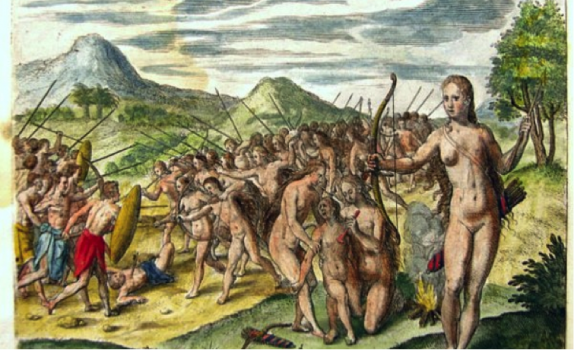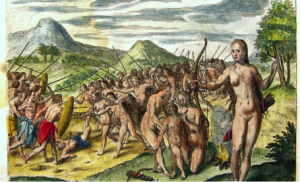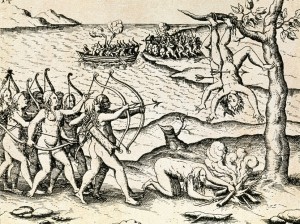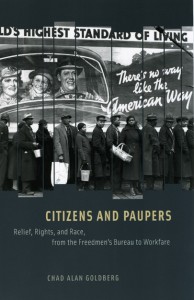The story of Carl Marzani (1912 – 1994) does not fail to disappoint. Hostos College Historian Marcella Bencivenni presents the highly politicized life of Marzani—a charismatic and important figure of the Left—as the first victim of McCarthyism, the US national witch-hunt for communist spies and sympathizers during the Cold War. Bencivenni’s narrative of Marzani serves as a timely (the 2016 US presidential nominations are a spectacle to behold) microcosm illustrating the oftentimes frustrating clash of political leaders, discourses of national security, public intellectuals, media narratives, and public opinion. Bencivenni’s research, in preparation for her forthcoming book on Marzani, takes what one audience member called a “moderate stance” to the accusations of espionage hurled at Marzani, who served in the United States Government department of the Office of Strategic Services (OSS): the first intelligence office of government, predating the Central Intelligence Agency (CIA).
As members of the Marzani family looked on, Bencivenni described the impressive figure of Carl Marzani. Marzani, migrating at the age of 12 from fascist Italy, was the son of a socialist postal worker father who refused to sign Mussolini’s loyalty pledge. Subsequently they were forced to flee Rome for the mining community of Scranton, NY. Marzani was a successful student, receiving scholarships to both Williams College and Oxford. In Britain he joined the British communist party, and upon return to the US, joined the US communist party.
Marzani was a Marxist intellectual and excellent speaker and debater who would “talk at you” rather than with you. A prolific writer, Marzani translated the Marxist theories of Gramsci, and wrote the first revisionist history of the cold war. Notably, a young Bernie Sanders wrote an endorsement of Marzani’s memoir The Education of a Reluctant Radical. Demonstrating a jack-of-all-trades flexibility, Marzani also directed Deadline for Action (Union Films, 1946).
Marzani’s intelligence and skills would be recognized by Office of Strategic Services (OSS) director William Donovan, who recruited Marzani. Marzani’s tenure with the OSS, which according to one audience member “wouldn’t even be running if not for all the communists who worked there,” came to a grinding halt on March 17, 1947, when he was indicted by a federal grand jury—not for treason under the Smith Act, which might be expected —but rather under the False Claims Act, for defrauding the government. What was the nature of the fraud? Marzani’s denial of his membership with the communist party at his time of hiring at the OSS
The trial of Marzani was complicated from a legal perspective, but after a series of two split Supreme Court juries, on May 22, 1947, Carl Marzani was found guilty on all 11 counts and was sentenced to 1-3 years of jail time. Most relevant to the case were the competing discourses from the Right and Left news media. The Right’s narrative was epitomized in headlines such as “How the Reds do Business” by J. Parnell Thomas, who would ironically, become a civil servant himself and be slapped with the same charge as Marzani. Thomas would only serve 6 months of his term, unlike Marzani.
On the opposite side of the political spectrum, the Leftist discourse of the Marzani trial pointed to a pervading anti-intellectualism, decline of freedom, and the rise of fear within a police-state. An audience member who worked as a professor at the time of the trial told the audience about a deep fear among her academic community of being identified as a communist or sympathizer. Eleanor Roosevelt herself was outspoken about the attacks on freedom and the rise of fear.
In addition to describing the two prevailing narratives of the Marzani case, Bencivenni detailed a number of inconsistencies in the trial itself: the conditions of Marzani’s hiring, supporting documents such as the Venona Files, and the race/ethnicity of the nearly all-Black jury, which was nearly unheard of at the time. For the sake of brevity, I will write here about only one particular aspect of the case. Those interested in learning more must wait for Bencivenni’s book.
In the trial, the question of Marzani’s communist party membership and his hiring by the OSS is of import. Bencivenni notes that despite perjuring himself (by the way, with the blessing of his Catholic mother) by denying his membership in the communist party, a closer look shows that Marzani was really rather open about his radical past. Actual spies never had records of openness such as Marzani’s. For example, Director William Donovan, a smart, conservative Republican general was not averse to hiring radicals to win his competition with rival Edgar Hoover, head of FBI. In fact, after Marzani’s initial screening by the OSS the FBI informs the agency that he was a member of the communist party, after which Marzani is cleared of wrongdoing by the OSS. If this is the case, asks Bencivenni, then why deny membership in the communist party in the trial? Bencivenni states that the answer to Marzani’s denial of membership is that he’d have to name names, which is the ultimate objective of Hoover and the US government; moreover, Marzani underestimated his potential prison term, which he anticipated would only last a few months.
Bencivenni closes by reminding us that archival data doesn’t provide enough evidence to prove that Carl Marzani was a spy; moreover, the element of espionage is not the most important part of the story. The heart of the Marzani narrative is the struggle with notions of freedom, such as intellectual freedom. Marzani was a vocal and public voice of dissent to the cold war consensus. Bencivenni goes as far as describing this message as prophetic, and as far as prophetic voices are fiercely suppressed and attacked this much appears true. The result of the Marzani trial was that that communism as an intellectual and political project—irrespective of its intrinsic qualities—was suppressed. The account is a scathing critique of an ideology of freedom, supposedly a guiding US national ideology. According to Bencivenni, the result was a diminishment of America as an idea, supporting an atmosphere of anti-intellectualism. As a result communism is deprived of its legitimacy in the US, in contrast to European states. In the US, the academy is one of the only places remaining in which one may engage with ideas and projects typically labelled “radical.”
And so we return to the characteristic timeliness of the Bencivenni’s interpretation of the life of Carl Marzani. Judging from the political rise of an extremist Right and a far-left presidential nominees (Trump, Sanders), it is apparent that the electorate resonates with the complex mixture of stump-speeches that contain messages fear, xenophobia, economic insecurity, as well as a growing repudiation of social and economic inequality, and a desire for political reform. As in the historical period of Marzani, we are witness to both a discourse of anti-intellectualism, and systemic political change. We would do well to be reminded by the tendency for some political leaders to lead humanity towards the former rather than the latter.
–Daniel Vallee












